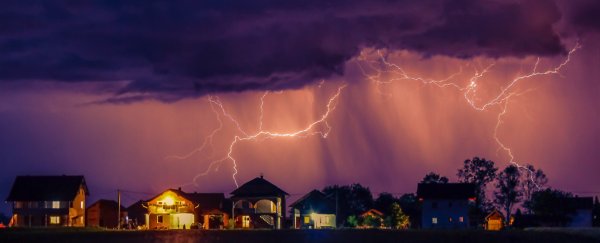You've seen it, you've heard it, but have you ever smelled it? As bizarre as it sounds, lightning has a distinct odor.
But unlike its blinding flash or deafening roar, the scent of a lightning bolt is much more subtle. In fact, you've probably experienced it before.
Whenever lightning strikes, it heats the air to 30,000 degrees Celsius (50,000 degrees Fahrenheit)! The rapid expansion of the air produces a sonic boom that you hear as thunder.
However, at the molecular scale, chemical changes can alter the atmosphere on a highly local level and leave behind an aroma.
The air is 78 percent nitrogen and barely 20 percent oxygen. Neither nitrogen nor oxygen typically exists in its elemental form in the atmosphere.
Instead, two of each pair up as N2 or O2. When the lightning heats the air, it splits the bonds between them - and that's when random Ns or Os can start hopping around.
Most of the atoms pair back up once the air cools. But some reshuffle. Some of the O atoms combine with O2, producing O3: ozone. It's unusual to get large concentrations of ozone at the surface, and it has a distinct scent. It is noticeable right after a lightning strike.
Ryan Long, 20, experienced this himself in Oxford, Alabama, in June. "I was at work in an old building atop a hill in the cemetery," Long said.
"Suddenly there was a blinding white spark of light," he recalled. Lightning struck just yards away.
"It sent static up my arm," he said. "It smelled like something inorganic burning, like wires or plastic."
Others have compared the odor to chlorine, cleaning supplies or, unsurprisingly, electrical sparks.
Odds are, you've smelled lightning-produced ozone before. You know that clean, crisp smell ahead of a springtime rain?
That's it. Even if there's barely any lightning, there are still trace amounts of lightning-produced ozone and nitrogen dioxide in the air scattered about the storm.
When the gust front of a storm carries it out ahead of the rain, you can smell it before it's "scavenged" to the ground.
The human nose can detect ozone concentrations as little as 10 parts per billion. That's the equivalent of three teaspoons of water in an Olympic-size swimming pool.
You may smell it when doing laundry, too. Those little static sparks between clothes coming out of your drier act as miniature lightning bolts, producing just enough ozone for you to get a whiff.
Next time you're in a thunderstorm, take a big ol' deep breath. You may just be smelling lightning.
2018 © The Washington Post
This article was originally published by The Washington Post.
